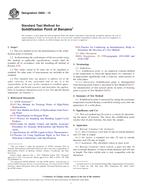1.1 This test method covers the procedure for determining the point resistance during penetration of a conical-shaped penetrometer as it is advanced into subsurface soils at a steady rate.
1.2 This test method is also used to determine the frictional resistance of a cylindrical sleeve located behind the conical point as it is advanced through subsurface soils at a steady rate.
1.3 This test method applies to friction-cone penetrometers of the electric and electronic type. Field tests using mechanical-type penetrometers are covered elsewhere by Test Method D 3441.
1.4 This test method can be used to determine porewater pressures developed during the penetration, thus termed piezocone. Porewater pressure dissipation, after a push, can also be monitored for correlation to time rate of consolidation and permeability.
1.5 Additional sensors, such as inclinometer, seismic geophones, resistivity, electrical conductivity, dielectric, and temperature sensors, may be included in the penetrometer to provide useful information. The use of an inclinometer is highly recommended since it will provide information on potentially damaging situations during the sounding process.
1.6 Cone penetration test data can be used to interpret subsurface stratigraphy, and through use of site specific correlations, they can provide data on engineering properties of soils intended for use in design and construction of earthworks and foundations for structures.
1.7 The values stated in SI units are to be regarded as standard. Within Section 13 on Calculations, SI units are considered the standard. Other commonly used units such as the inch-pound system are shown in brackets. The various data reported should be displayed in mutually compatible units as agreed to by the client or user. Cone tip projected area is commonly referred to in square centimetres for convenience. The values stated in each system are not equivalents; therefore, each system must be used independently of the other. Note 1This test method does not include hydraulic or pneumatic penetrometers. However, many of the procedural requirements herein could apply to those penetrometers. Also, offshore/marine CPT systems may have procedural differences because of the difficulties of testing in those environments (for example, tidal variations, salt water, waves). Mechanical CPT systems are covered under Test Method D 3441.
1.8 This standard does not purport to address all of the safety concerns, if any, associated with its use. It is the responsibility of the user of this standard to establish appropriate safety and health practices and determine the applicability of regulatory limitations prior to use.
Product Details
- Published:
- 11/01/2007
- Number of Pages:
- 19
- File Size:
- 1 file , 720 KB


